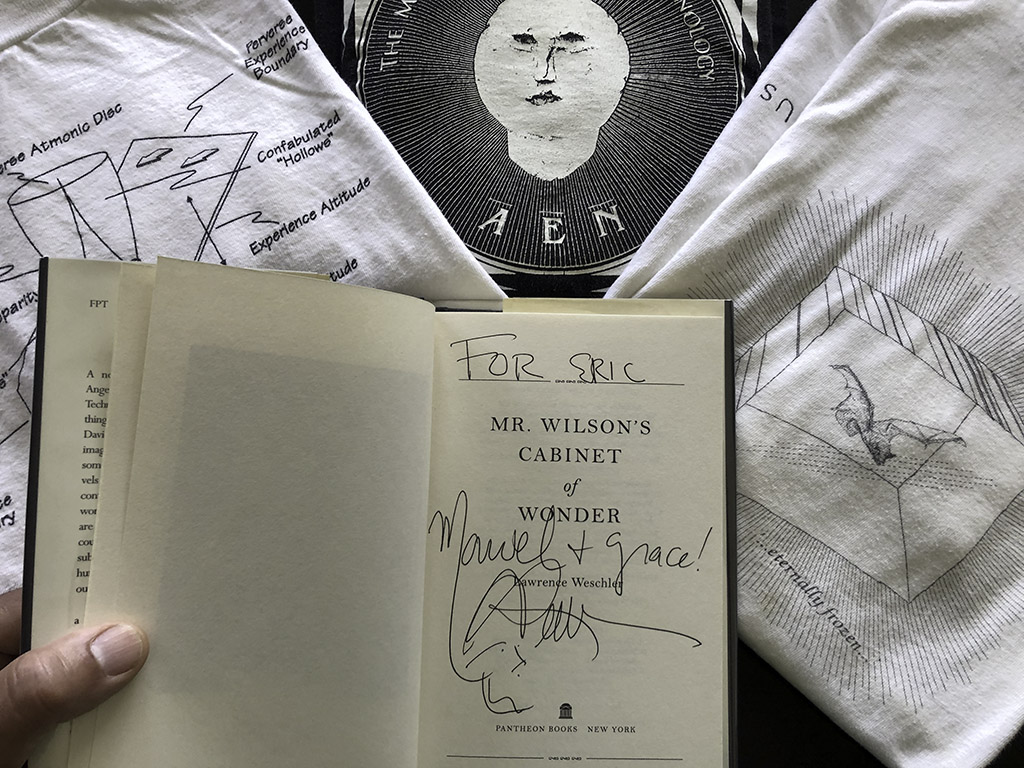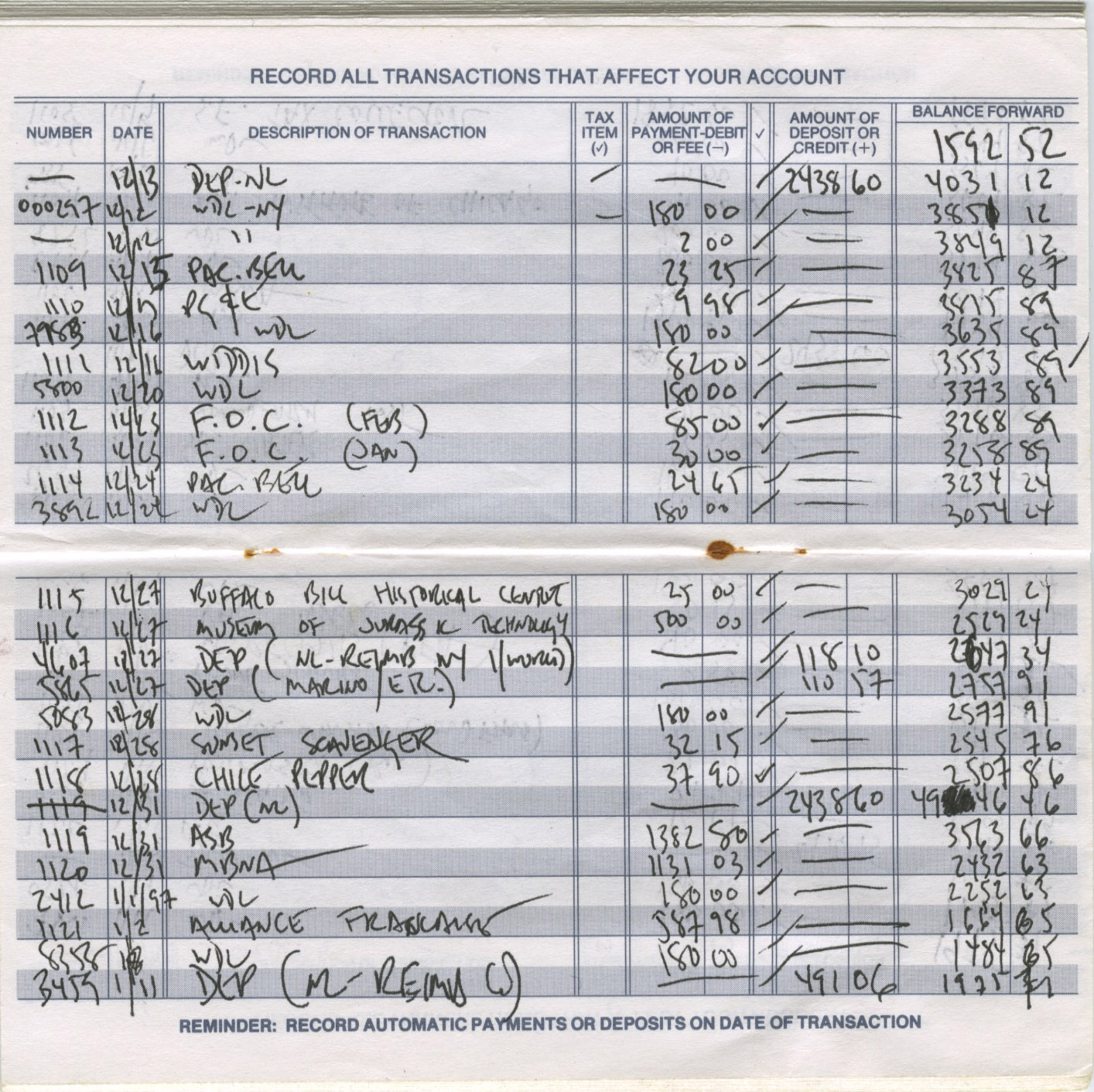Lawrence Weschler’s Seeing Is Forgetting The Name Of The Thing One Sees: A Life of Contemporary Artist Robert Irwin and True to Life: Twenty-Five Years of Conversations with David Hockney are essential for an understanding of those artists’ thinking, the trajectories of their careers, and the impacts of their work. But when Weschler lectured at the San Francisco Art Institute (9 Feb 2009) in commemoration of the University of California Press’ publication of expanded editions of his Irwin and Hockney books, the book I brought for him to sign was neither of those.
It was Mr. Wilson’s Cabinet of Wonder: Pronged Ants, Horned Humans, Mice on Toast, and Other Marvels of Jurassic Technology, his flawless and delightful investigation into the Museum of Jurassic Technology and its founder, David Wilson. The book was my introduction to the surprisingly scrappy history of how personal and idiosyncratic cabinets of curiosity evolved into the public institutions we in the West recognize as museums today. The book shines brightest when Weschler’s quest to debunk what appears impossible, outrageous, and obviously false leads to deeper, more profound truths and occasionally implicates him through implausible coincidences.

My Own Curiosity Cabinets
I spent a lot of time sifting and weeding through folders of ephemera during the COVID-19 lockdown; not always a pleasant, nostalgic activity. One of the least pleasant realizations: everytime I donated more than the typical amount of money to a cultural institution here in California it was a struggle, if not an impossibility, to reap the promised benefits.
[file cabinets]
Ironic that the first occurrence came from a meta-museum.
Visits, Donation, Estrangement
I was involved with two projects at the Exploratorium during my early years in San Francisco: Tracing Time in 1992 and Multimedia Playground in 1994. When friends who worked there heard I’d be traveling to Los Angeles they insisted I visit the Museum of Jurassic Technology but were puzzlingly tight-lipped about why, or what would await me. This turns out to be absolutely the correct approach and one I’ve followed when I used to recommend that people visit.
On my first visit my then-romantic-plus-business partner and I had opposite reactions. I was captivated, as much by the presentation as the subjects: the dioramas, the low tech but successful special effects, the dense yet inconclusive didactics. She, on the other hand, grew increasingly angry as we wandered from room to room. Jaws clenched, fists clenched; enraged. It was only when we were discussing our visit at a party back home a few days later, and she began to understand that the Museum had a cult following, that she shapeshifted into an enthusiast.
As is my nature I’d picked up brochures and handouts at the Museum. I was drawing what seemed a good salary in the early days of the first dotcom boom so at the end of 1996 I responded to the Museum’s Invitation to Participate with a check for $500 (#1116, 27 Dec).

Some time later I received a package in the mail containing the t-shirts acting as backdrop to Weschler’s book in the first photo above (XL suited me then; happily L, sometimes M, is the correct fit these days), a lapel pin and membership card, three books, and three pieces of china related to Museum exhibits. For years I sought out the type of wall hanger for china that my oma had in her apartment, eventually finding a perfect match at the Mother Of Sorrows Pioneer Shrine & Gift Shop in Mabou, Nova Scotia. I hung the plate commemorating the Delani/Sonnabend Halls on my living room wall where it remains more than two decades later.
[Delani/Sonnebend Halls plate & receipt]
It may be time to sell it on eBay, purging, as I’ve done with the shirts and other plates.
For a few years I received mailed invitations announcing exhibits and special events at the Museum. The timing may have been suitable for Los Angeles residents but it was rare for an invitation to arrive far enough in advance for me to book a reasonably-priced flight. Somehow I managed to travel to LA for An Illustrated lecture by Rosamond Purcell, held on 14 Feb 1998 in conjunction with the MJT’s exhibit of her Special Cases.
That was the first time I noticed that my name was not listed on the donor wall. I reported the omission to the helpful, concerned person behind the cash register in the gift store; they took my contact info and promised to follow up.
I next visited the MJT in 1999, the year I seem to have been dropped from the mailing list for announcements of new exhibits. I visited again in July 2002, and for the last time in December 2004. On each visit I failed to find my name on the donor wall. On each visit I left my contact information and was assured someone would look into it.
If I had to pick the “privilege” that meant the most to me, my name appearing on the donor wall would be the one. Books, the lapel pin, t-shirts, china, they’re all nice-to-haves. But face it: the donor wall is an index to individuals’ “discovery” of the Museum and absorbing what it’s up to.
(I may be overly fascinated by donor walls, at institutions ranging from sizable metropolitan museums to small town chili parlors. I have a few theories and may dig into them in the future but the failure of arts institutions to fulfill their side of the bargain has led to my estrangement from more than one.)
I have not returned to the Museum since that 2004 visit. I have stopped visiting the adjoining Center for Land Use Interpretation, and it’s rare I visit Culver City and its galleries. It’s unfortunate. But who needs a reminder that their charitable gift, given in support and admiration of an institution, was met with failed promises and dismissive behavior?
I chalked it up to being a lesson in dealing with nonprofit arts organizations.
A Forgotten Privilege
I was apparently more forward thinking then than now and, during lockdown, came across a folder devoted to the MJT that contained a copy of that Invitation to Participate.

I’d remembered that my donation was to provide a membership card, an etched brass label [sic] pin, invitations to Museum events, free admission for two, a $10% [sic] discount at the gift shop, a T-shirt, a listing on the Museum’s donor board, and a special gift produced by the Museum (perhaps the three books were the “special gift”).
What I’d completely forgotten was that a $500 donation was to provide life-time membership.
What kind of institution drops lifetime members from communications about its doings? Newly disgusted, I emailed the Museum on 10 June 2021. Yes, that was during lockdown. No, in two years I never received a response.
Date: Thu, 10 Jun 2021 11:55:16 -0700
Subject: donor board & life membership
To: info@mjt.org
Dear MJT,
On December 27th 1996 I wrote check #1116 in the amount of $500 in response to your "Invitation to Participate". I did receive some books, some plates, some t-shirts, and the lapel pin. But on my subsequent three or four visits to the Museum I never could locate my name on the donor board. Each time I inquired of a docent or gift store cashier, each time I left contact information either on a scrap of paper or via a business card. I probably haven't returned to the Museum since 2002 or 2003, partly because I'm not local but partly because I have little faith the donor board issue's been resolved.
Would you send me a photo of my name as it appears on the donor board?
I also don't understand why there's no communication with Lifetime Members. It appears that the last communication I have from the Museum is an invitation to the 2005 Yuletide Celebration.
Thanks for any insights.
Eric
& so on the two year anniversary this is mine.
Speaking Candidly
I don’t pretend to understand the relationship between Candid and The Foundation Center. I believe the latter was acquired by the former but some of their products, notably the Foundation Directory, retain the latter’s domain name. The subscription-based Foundation Directory is a critical resource for individuals and institutions seeking financial or other support through grantspersonship. Under the right circumstances it’s possible to access the database in person; I was fortunate to have been able to access it when The Foundation Center had an office on Sutter St, near Union Square in San Francisco; I continue to be fortunate in that our Public Library has a subscription and makes it available for in-person use at the Main Branch. The information I’ll discuss is also available more widely in ProPublica’s Nonprofit Explorer.
The Foundation Directory tabulates donorship using the publicly available 990 and 990-PF tax forms required of private foundations and public charitable organizations. It’s possible to export this information in various formats, including barebones csv files, which can be taken home on thumbdrives and subsequently be pulled into spreadsheets or databases and visualized.
Interesting.
Note that the default scale for the proceeding graph is logarithmic with each major vertical division being another power of ten. Click linear to see how the Annenberg Foundation’s granting dwarves even the Warhol Foundation’s and the Getty Trust’s.
The Foundation Directory also provides contact information for the granting organizations listed in its databases; this ranges from addresses at Post Office Boxes to email addresses of named individuals.
This information paves the way for a disaffected donor such as myself to contact granters and to ask them to reconsider their gifts to nonprofits having dubious business practices. I’m following this up by filing a complaint to the California Attorney General.
We’ll see how it goes. This a warmup for things to come under the major gifts tag.